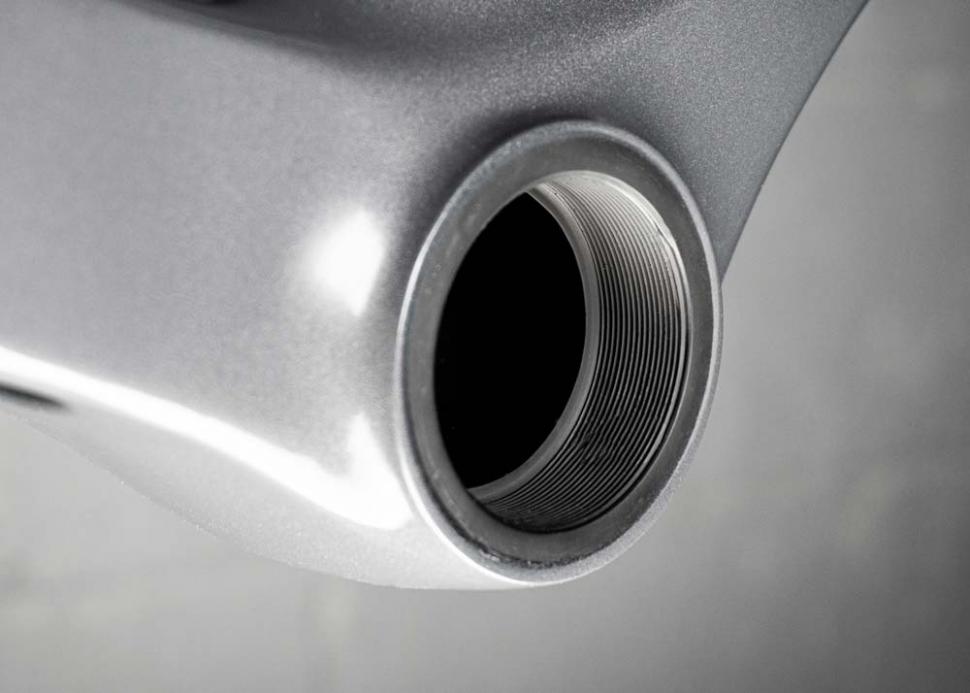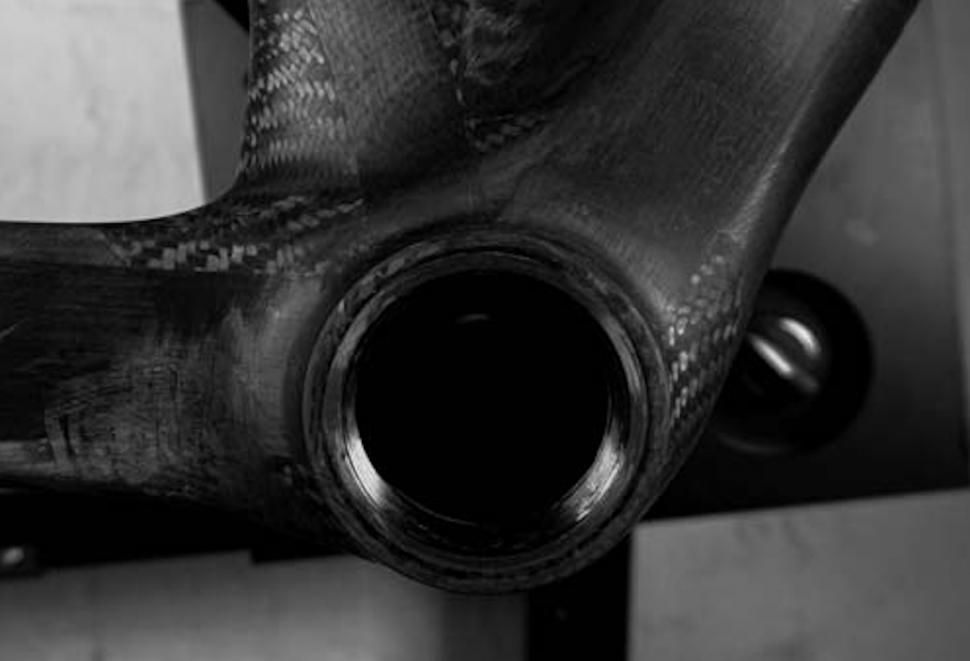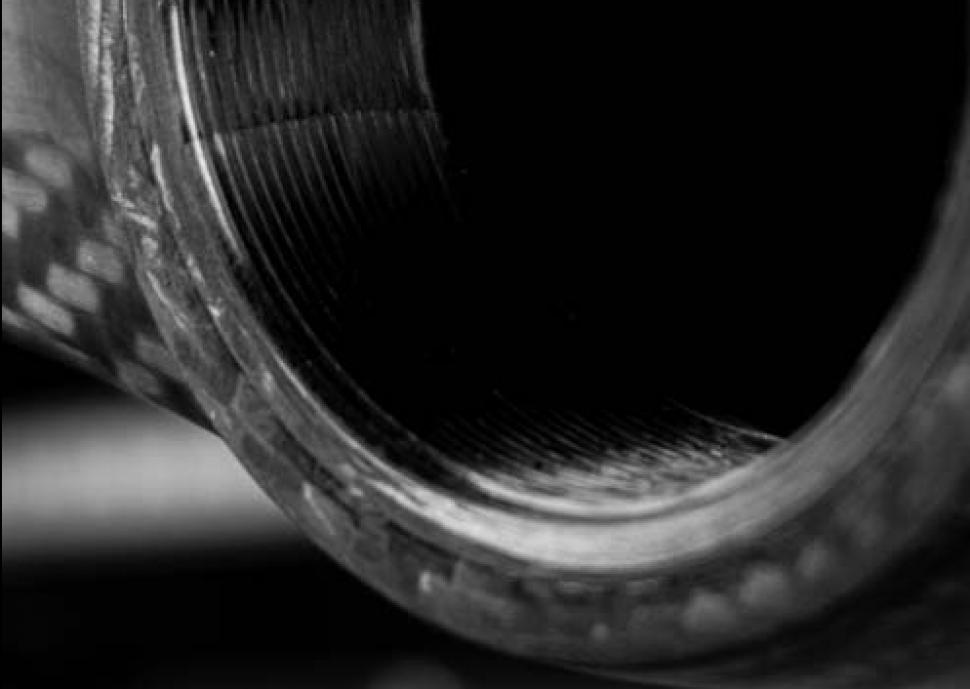- News
- Reviews
- Bikes
- Accessories
- Accessories - misc
- Computer mounts
- Bags
- Bar ends
- Bike bags & cases
- Bottle cages
- Bottles
- Cameras
- Car racks
- Child seats
- Computers
- Glasses
- GPS units
- Helmets
- Lights - front
- Lights - rear
- Lights - sets
- Locks
- Mirrors
- Mudguards
- Racks
- Pumps & CO2 inflators
- Puncture kits
- Reflectives
- Smart watches
- Stands and racks
- Trailers
- Clothing
- Components
- Bar tape & grips
- Bottom brackets
- Brake & gear cables
- Brake & STI levers
- Brake pads & spares
- Brakes
- Cassettes & freewheels
- Chains
- Chainsets & chainrings
- Derailleurs - front
- Derailleurs - rear
- Forks
- Gear levers & shifters
- Groupsets
- Handlebars & extensions
- Headsets
- Hubs
- Inner tubes
- Pedals
- Quick releases & skewers
- Saddles
- Seatposts
- Stems
- Wheels
- Tyres
- Health, fitness and nutrition
- Tools and workshop
- Miscellaneous
- Buyers Guides
- Features
- Forum
- Recommends
- Podcast
TECH NEWS
 2023 Bridge Bike Works Carbon Bottom Bracket
2023 Bridge Bike Works Carbon Bottom BracketHas Bridge Bike Works reinvented the bottom bracket? New tech sees BB threaded directly into carbon frames
Toronto-based bicycle component manufacturer Bridge Bike Works has unveiled some intriguing new bottom bracket technology for carbon fibre frames that means the threads are moulded directly into the frame, promising no more creaks. Is this the future of bottom brackets?
There are two main types of bottom brackets, threaded or press-fit, which (and this is an understatement if there ever was one) sparks controversy about which is best. This new 'Integrally Threaded Carbon Bottom Bracket' from Bridge opens a whole new can of worms, with the first production version of this new technology being seen at this year's Sea Otter Classic in California.
> Bottom brackets - get the insider info on your bike's beefiest bearing
Threaded bottom brackets are the most common, and are often preferred for their ease of installation and maintenance. Bridge says, "threaded bottom brackets are the best option" as they are considered less likely to develop creaks than press-fit bottom brackets.
Bridge claims it has found a lighter, more simple and corrosion-resistant solution to bottom bracket sleeves used in threaded bottom brackets, by producing moulded threads directly into carbon fibre bottom brackets. This is said to be more reliable and robust than threaded metal interfaces.
Threaded bottom brackets often feature an aluminium shell which is bonded into the carbon, but this integrally threaded carbon bottom bracket is "fundamentally part of the frame", claiming to save in the region of 100g on materials.
> How to fit a threaded bottom bracket in 9 easy steps
Moving on to alignment, Bridge says that the bottom bracket can be perfectly aligned due to the threads being moulded into shape, promising that it won't creak or seize.
As we know, carbon can be soft or brittle and reacts with alloys and other materials to create corrosion. By eliminating the metal shell of a threaded bottom bracket, Bridge claims its carbon bottom bracket is corrosion-resistant. The threads also have a Cerakote ceramic coating aimed at creating a more robust barrier between the carbon frame and bearing cups, and this is said to make the carbon fibre stronger.
> Understanding carbon bike frames
Bridge says it has enhanced longevity by eliminating parts of the processes, meaning less can go wrong and having threads with dirt collecting properties.
This new technology is said to be compatible with many standard bottom brackets, with Bridge opting for the standard T47-86 bottom bracket on its Surveyor bikes.
Would you trust an 'integrally threaded' carbon bottom bracket? Let us know in the comments section below...
Emily is our track and road racing specialist, having represented Great Britain at the World and European Track Championships. With a National Title up her sleeve, Emily has just completed her Master’s in Sports Psychology at Loughborough University where she raced for Elite Development Team, Loughborough Lightning.
Emily is our go-to for all things training and when not riding or racing bikes, you can find her online shopping or booking flights…the rest of the office is now considering painting their nails to see if that’s the secret to going fast…
Latest Comments
- hand0j1n 7 hours 19 min ago
Hopefully the new device is a big success, but wahoo do have a lot work to do in terms of convincing that their quality control has improved. ...
- chrisonabike 6 hours 9 min ago
Agree that the moaning comes from a place of priveledge and ultimately "if only there weren't so many other people driving"....
- Simon E 7 hours 55 min ago
Have added some clarification....
- Simon E 8 hours 4 min ago
I was tempted to try Galibier gloves but opted for Endura Freezing Point from LBS last year. Not cheap (£60, I think). I'd prefer a shorter cuff...
- Simon E 8 hours 42 min ago
I can't wait that long! Here's a series that any good vlogger / 'grammer would surely recognise....
- Simon E 8 hours 50 min ago
At 2.30pm on Saturday a small hatchback car "came to rest on its side in a precarious position" near the hamlet of Ratlinghope on the west side of...
- IanMK 9 hours 28 min ago
I do wonder if Highway Planners and Councils understand all the implications of putting in traffic calming measures. They certainly take no...
- Oldfatgit 9 hours 47 min ago
How long before some waste of DNA complains about them on the footpath ... or for Grimsby [and the other shit-tips] to ban them ...
- mattw 10 hours 35 min ago
I've only just spotted this....
- Another_MAMIL 10 hours 59 min ago
I also liked Polartec NeoShell and was disappointed it was discontinued. Polartec RPM looks similar, but it's unclear how NeoShell and RPM compare....



Add new comment
40 comments
Threads made from threads - makes a certain amount of sense
This... will not age well.
Or these even. These BB threads.
Threads moulded directly in the carbon fibre?
Ha ha ha ha ha
Oh wait, you're serious. Let me laugh even harder.
A-HA HA HA HA HAAAA
So they dont have the tech to make a press fit BB that doesn't squick because of loss manufacturing tolerances but they can make a fine threaded BB shell no problem
Threads in the frame material, like with metal frames. Not much of an "invention" there me seems.
If this works, and lasts, it sounds like big progress.
It's included on Bridge's latest bike, the Surveyor which, strange name aside, is a beautiful bit of kit in its own right.
Not sure it's beautiful enough for me to risk a few grand on an unproven BB though!
Wouldn't the carbon threads break sometimes? Would this be fixable?
Apparently not. Apparently so.
Interview with co-founder of company:
https://youtu.be/mVSJ_ameqlA
There aren't 2 main types of bottom bracket, there's only one and that's press fit.
A threaded bottom bracket is just sealed bearings press fitted into cups that are then threaded into something else like a sleave or the frame.
The real reason we've gone back to using threaded bottom brackets, even though they're technically a worse design than something like BB86, is that carbon frames are just made to such poor standards.
That you can spend £11,000 on a big name bike and the frame holes aren't round is a disgrace.
It'll be interesting to see if any journalists actually bother checking to see if these new threaded BBs are well aligned or round.
Sadly, based on all the tyres that get described as "supple" for no reason other than the sidewalls being dyed brown I doubt it.
Being an engineer is about picking your battles and not letting perfect being the enemy of good, obviously current manufacturing standards aren't conistently good enough for press fit direct into the BB so the work around of press fit into a threaded component is the best method at the moment. This will no doubt change as new manufacturing methods are developed.
That's not true, or at least not universally true. Both Shimano and Sram's default BBs have the bearings as a fundamental part of the threaded assembly. Downside, of course, is that they are not serviceable and must be discarded and replaced when worn out, but they tend to be at the cheaper end of the scale anyway.
Even if you are using a BB system with replaceable bearings, there is also the fact that the bit you are pressing the bearings into is, itself, replaceable so when you've pressed a few bearings into it, if the BB shell starts to get worn, you can unthread it, and replace it returning the BB to "as new". Couple this with a one-piece shell and you'll also have half decent alignment in the frame, regardless of the shoddy construction.
Actually it is true for Shimano BB-52/51 Hollow Tech 2 bottom brackets, they use 6805 bearings.
They can be removed and replaced if you want to, nobody does be the Shimano units are pretty cheap (as are the 6805 bearings Shimano use).
I suspect it's true for SRAM too but haven't checked.
Another step back in the industry. This is not what people want. Press fit is much higher performance, no question. I'd take a creaking press fit bottom bracket over a threaded one any day. I care about the performance of my bike, and I can feel the difference between threaded (slow, draggy) and press fit (fast, free spinning). My bike is fast just how I like it (rim brakes, 23 mm tyres, press fit bottom bracket) and I'm not interested in changing for something worse.
I care about the performance of my bike, and I can feel the difference between threaded (slow, draggy) and press fit (fast, free spinning).
Sure you can, Mr. Need
Care to explain how you measure the "slow & draggy" and "fast & spinny". Total bullshit.
It's simple really. Put your bike on a stand and give the cranks a quick spin and then see how quickly they come to a stop.
I'll just try it now with my push-fit BB and would you believe it, my Ultegra crank snapped.
And after all that, do you think the spinny press fit is saving you any watts? I'll answer for you. No! So it makes not a blind bit of difference
I'm not understanding how this combats corrosion between metal and cf - haven't they just moved the interface between the two to be the threads? I would think that would increase the surface area for corrosion and also the threads are much thinner that the traditional interface between push-fit BBs and cf frames.
I'm also wondering how long the threads last as they don't appear to be replaceable.
The current concern with corrosion is the interface between the carbon frame and the bonded-in aluminium alloy shell, regardless of whether that be for a threaded or a press-fit BB. If that bond breaks down due to corrosion, then the shell breaks loose and the frame is rendered useless, unless it can be properly reinstalled which may be very difficult, costly or even impossible. At least with the moulded thread you can avoid the corrosion issue by preiodically removing the BB and cleaning thread, which obviously you can't do with the bonded shell. Also you would usually have grease on the threads which should help reduce corrosion anyway.
Okay, that makes more sense now. However, you probably don't want to go putting ordinary grease onto carbon fibre - I've heard of it causing swelling/delamination with seatposts which is why carbon assembly paste is recommended instead. Maybe they have a specific grease to recommend - it just needs to avoid the surfaces bonding.
Carbon assembly paste is used to increase friction between the components, and has abrasives in it to help acheive this, but yes the carrier is carbon friendly. There are plenty of carbon friendly greases available from the likes of Park Tools.
Airplanes have been bonded together for years and years without any concerns about corrosion between carbon and aluminum.
I thought maybe this was a sarcastic comment? Let's just go with "that's the least accurate statement I'll hear this week".
That's very true, but then airplane manufacturers take a LOT more care in ensuring that parts are bonded together properly, and that potential corrosion is eliminated, on account of if they get it wrong many people will die! Bike frames on the other hand are subject to significantly lower quality control measures, with much wider tolerances, and are then 'abused' throughout their lifetime on salty road and/or muddy trails, often with little or no maintenance.
Airplane manufacturers do things like have multiple workers, with one to observe and check. And then they have another set of workers do proper QA afterwards, to make sure there are no defects.
Bike manufacturers just outsource stuff to Asian vendors, who oursource production to a number of Chinese shops that churn out stuff as fast as possible with incredibly low-paid workers.
David Arthur, once of this parish, had an interview with the co-owner of the company on his YouTube channel recently.
Apparently, the threads are almost indestructible but if you do manage to destroy them you can, apparently, "bore out" the threads and put an aluminium insert in.
Obviously got to take his word for that but if he is right it does sound like you'd get a second bite of the cherry compared to a normal CF frame with BB failure.
Okay, that's sounding a little bit better though I wouldn't trust myself to bore out the threads.
Yes, that definitely sounds like a specialist job!
Maybe a trained rodent with sharp, ever-growing teeth?
Pages